Table of Contents
Introduction Important Questions for Class 12 Economics,Concept of Price Elasticity of Demand and Its Determinants
1. Price Elasticity of Demand It is the ratio between percentage change in quantity demanded and percentage change in own price of the commodity. It is represented by a symbol (Ed ). In other words, Price Elasticity of Demand is the responsiveness of quantity demanded to change in price.
2.Methods of Measurement of Price Elasticity of Demand

(iii)Total Expenditure/Total Outlay Method (TE) = Price x Quantity or PxQ
This method only caputre the degree of elasticity and not the actual value elasticity.
3.Degrees of Price Elasticity of Demand
![]()
(ii)Perfectly inelastic
(iii)Unitary elastic demand (Ed = 1)
(iv)Greater than unit elastic demand (Ed >1) (v) Less than unit elastic demand (Ed < 1)
4.Relationship between Price, Total Expenditure and Elasticity
(i) When price (P) and Total Expenditure (TE), changes in same direction (i.e. with rise in price, TE also rises and vice-versa), elasticity is less than unity or inelastic.
(ii)When price (P) and Total Expenditure (TE), changes in the opposite direction (i.e. with rise in price TE falls and vice-versa), elasticity is greater than unity or elastic.
(iii)When price changes (i.e. rises or falls) TE remains constant, elasticity is equal to unit or unit elastic
 5.Factors Affecting Elasticity of Demand
5.Factors Affecting Elasticity of Demand
(i)Nature of commodity
(ii)Availability of substitutes
(iii) Diversity of uses
(iv)Postponement of uses
(v)Income level of the buyers
(vi)Habit of consumers
(vii)Proportion of income spent on a commodity
(viii) Price level
(ix) Time period
Previous Years Examination Questions
1 Mark Questions
1.Give the meaning of inelastic demand.(All India 2014) (Delhi 2009)
or
When is demand said to be price inelastic?(HOTS; All India; Delhi 2013,2009)
or
When is the demand for a good said to be inelastic?
Ans. When percentage change in quantity demanded is less than percentage change in price, the demand is said to be inelastic.
2.Give the meaning of Price Elasticity of (All India 2011)
Ans. Price Elasticity of Demand is the responsiveness of quantity demanded to change in price.
3.Why is demand for water inelastic? (hots; Delhi 2010)
Ans. Demand for water is inelastic because change in price does not affect the demand for water as water is essential for life.
3 Marks Questions
4.8 units of a good are demanded at a price of ? 7 per unit. Price Elasticity of Demand is (-) 1. How many units will be demanded if the price rises to ? 8 per unit? Use expenditure approach of Price Elasticity of Demand to answer this question.(Delhi 2011)
Ans.
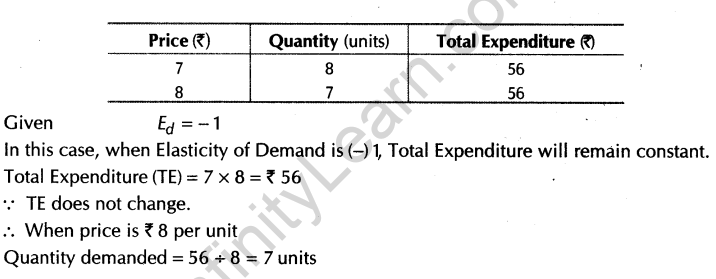
5. A consumer buys 10 units of a good at a price of ? 6 per unit. Price Elasticity of Demand is (-) 1. At what price will he buy 12 units? Use expenditure approach of Price Elasticity of Demand to answer this question (Delhi 2011)
Ans.
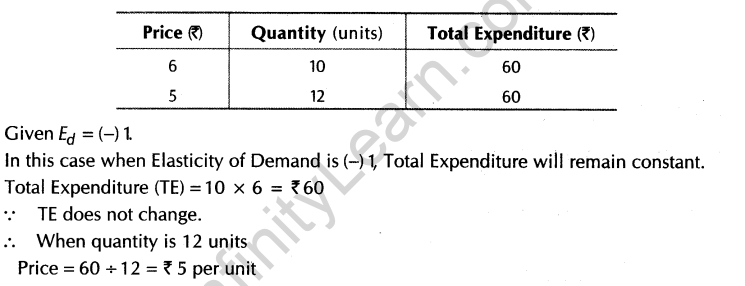
6.When price of a good is 13 per unit, the consumer buys 11 units of that good. When price rises to 15 per unit, the consumer continues to buy 11 units. Calculate Price Elasticity of Demand. (All India 2011)
Ans.

7.When price of a good is 12 per unit, the consumer buys 24 units of that good. When price rises to 114 per unit, the consumer buys 20 units. Calculate Price Elasticity of Demand. (All India 2011)
Ans.


8.From the following table, calculate Price Elasticity of Demand.(All India 2011)
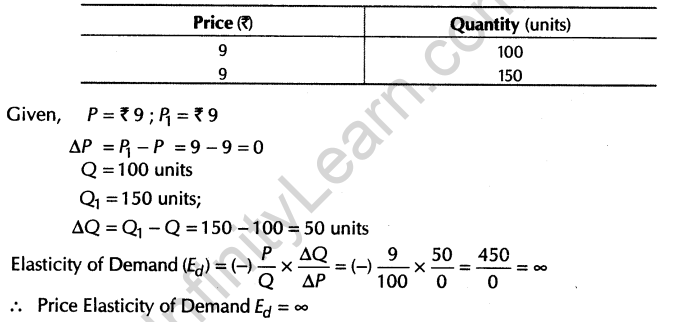
9.Explain any two factors that affect Price Elasticity of Demand. (Delhi 2010; All India 2009)
Ans.The two main factors that affect Price Elasticity of Demand are:
(i) Number of substitutes of a goods Demand for goods which have close substitutes (like tea and coffee) is relatively more elastic. Because, when price of such a good rises, the consumers have the option of shifting to its substitute. Goods without close substitutes like cigarettes etc are generally found to be less elastic or inelastic in demand.
(ii) Proportion of income spent on the goods On which consumers spend a small proportion of their income (toothpaste, needles, etc) will have an inelastic demand. On the other hand, goods on which the consumers spend a large proportion of their income (cloth, television, etc) tend to have elastic demand.
10.Explain the effect of the following on Price Elasticity of Demand of a commodity, (i) Number of substitutes (ii) Nature of the commodity (All India 2010)
Ans. (i) Number of substitutes of a goods Demand for goods which have close substitutes (like tea and coffee) is relatively more elastic. Because, when price of such a good rises, the consumers have the option of shifting to its substitute. Goods without close substitutes like cigarettes etc are generally found to be less elastic or inelastic in demand.
(ii) Nature of the commodity Ordinarily, necessaries like salt, match boxes, medicines etc have less than unitary elastic (inelastic) demand. Luxuries, like air conditioner, costly furniture, car etc have greater than unitary elastic demand. Comforts like, cooler, fans etc have neither very elastic nor very inelastic demand. Jointly demanded goods like pen and ink etc shows a moderate Elasticity of Demand.
11.How is a Price Elasticity of Demand of a good influenced by availability of its close substitute? Explain by giving an example. (Delhi 2010; 2009)
Ans. Number of substitutes of a goods Demand for goods which have close substitutes (like tea and coffee) is relatively more elastic. Because, when price of such a good rises, the consumers have the option of shifting to its substitute. Goods without close substitutes like cigarettes etc are generally found to be less elastic or inelastic in demand.
12.Explain the geometric method of measuring Price Elasticity of Demand.(All India 2009,2008)
Ans. Geometric method measures Price Elasticity of Demand at different points on the demand curve. It is also called point method of measuring Elasticity of Demand.
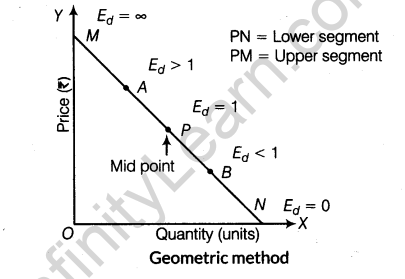
MN is a straight line demand curve sloping downward. P is a mid-point on the demand curve. It divides the demand curve into two equal segments, lower segment (PN) and upper segment (PM).
corresponding to a particular point on the demand curve.
13.A 5% fall in price of a good leads to 10% rise in its demand. A consumer buys 40 units of a good at a price of 10 per unit. How many units will he buy at a price of 12 per unit? Calculate.(All India 2009)
Ans.
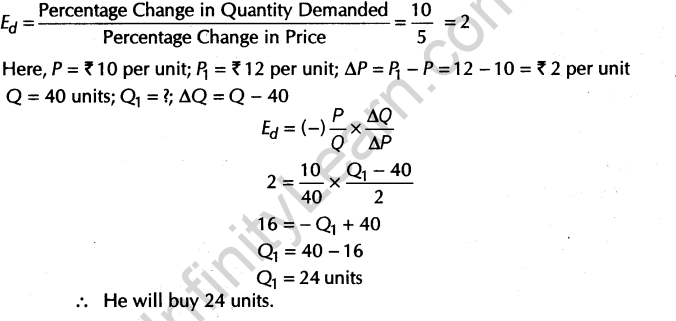
14.A 5% rise in price of a good leads to 5% fall in its demand. A consumer buys 100 units of a good when price is 5 per unit. At what price will he buy 120 units? Calculate. (All India 2009)
Ans.
15.When price of a good falls from ? 10 per unit to ? 9 per unit, its demand rises from 9 units to 10 units. Compare expenditure on the good to determine whether demand is elastic or inelastic. (Delhi 2009)
Ans.

16.When price of a good falls from 18 per unit to ? 7 per unit, its demand rises from 12 units to 16 units. Compare expenditure on the good to determine whether demand is elastic or inelastic. (Delhi 2009)
Ans.

17.Price Elasticity of Demand of a good is (-) 1. The consumer buys 50 units of that good when price is 2 per unit. How many units will he buy if the price rises to 4 per unit? Answer this question with the help of Total Expenditure method of determining Price Elasticity of Demand.(Delhi 2009 c)
Ans.

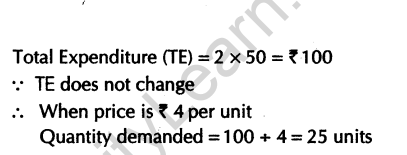 18.Price Elasticity of Demand of a good is (-) 1. The consumer spends ? 50 on the good at the prevailing price. When price changes, he buys 25 units. What is the new price? Use the Total Expenditure Method of calculating Price Elasticity of Demand to answer this question. (Delhi 2009c)
18.Price Elasticity of Demand of a good is (-) 1. The consumer spends ? 50 on the good at the prevailing price. When price changes, he buys 25 units. What is the new price? Use the Total Expenditure Method of calculating Price Elasticity of Demand to answer this question. (Delhi 2009c)
Ans.

19.When price of a good rises from ?.5 per unit to 16 per unit, its demand falls from 20 units to 10 units. Compare expenditure on the good to determine whether demand is elastic or inelastic.(Delhi 2008)
Ans.

20.Price Elasticity of Demand of a good is (-)1. At a given price, the consumer buys 60 units of the good. How many units will he buy if the price falls by 10%?(All India 2008)
Ans.
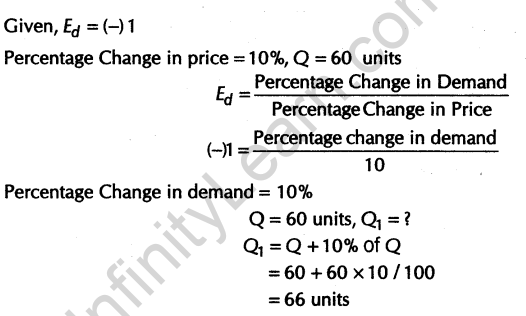
21.Price Elasticity of Demand of a good is (-) 2. The consumer buys a certain quantity of this good at a price of ? 8 per unit. When the price falls he buys 50% more quantity. What is the new price?(All India 2008)
Ans.
Ans.
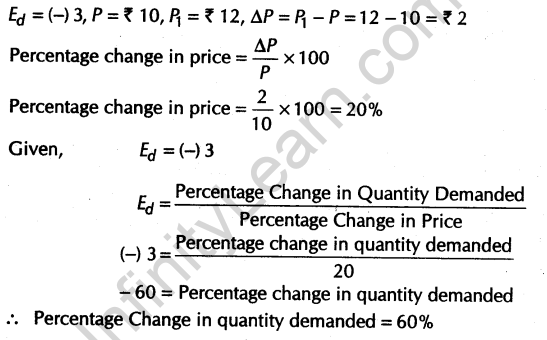 23.Due to a 10% fall in the price of a commodity, its quantity demanded rises from 400 units to 450 units. Calculate its Price Elasticity of Demand. (Delhi 2008 C)
23.Due to a 10% fall in the price of a commodity, its quantity demanded rises from 400 units to 450 units. Calculate its Price Elasticity of Demand. (Delhi 2008 C)
Ans.
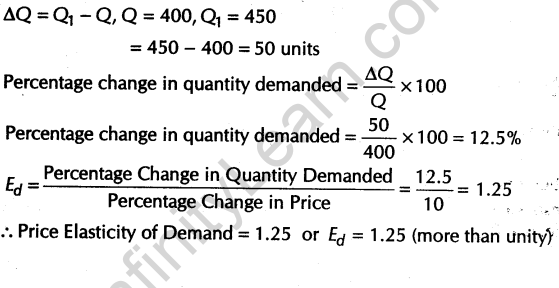
24.When the price of a commodity rises from 110 per unit to 11 per unit, its quantity demanded falls by 15%. Calculate its Elasticity of Demand. (Delhi 2008 C)
Ans.
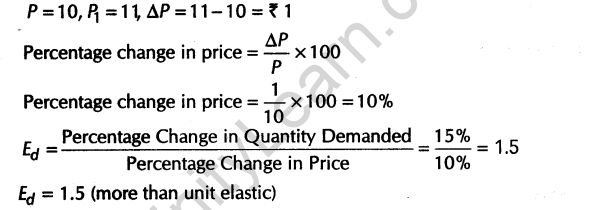
25. Explain any three factors that affect Price Elasticity of Demand of a commodity.(All India 2006)
Ans. Three factors that affect Price Elasticity of Demand of a Commodity are:
(i) Number of substitutes of a goods which have close substitutes (like tea and coffee) is relatively more elastic. Because, when price of such a good rises, the consumers have the option of shifting to its substitute. Goods without close substitutes like cigarettes etc are generally found to be less elastic or inelastic in demand.
(ii) Proportion of income spent on the goods On which consumers spend a small proportion of their income (toothpaste, needles, etc) will have an inelastic demand. On the other hand, goods on which the consumers spend a large proportion of their income (cloth, television, etc) tend to have elastic demand.
(iii) Nature of the commodity Ordinarily, necessaries like salt, match boxes, medicines etc have less than unitary elastic (inelastic) demand. Luxuries, like air conditioner, costly furniture, car etc have greater than unitary elastic demand. Comforts like, cooler, fans etc have neither very elastic nor very inelastic demand. Jointly demanded goods like pen and ink etc shows a moderate Elasticity of Demand.
26.State any four factors that affect Price Elasticity of Demand. (All India 2006)
Ans. Four factors that affect Price Elasticity of Demand are:
(i) Number of substitutes of a good
(ii) Proportion of income spent on the good
(iii) Nature of the commodity
(iv) Diversity of uses or number of uses
26.State the Total Expenditure (TE) method of measuring Price Elasticity of Demand.(Delhi 2006)
Ans. In this method, Price Elasticity of Demand is measured by comparing the Total Expenditure on commodity before and after the price change. The following possibilities are:
(i) When TE increases with the fall in price and decreases with the rise in price then there is elasticity greater than one.
(ii) When TE remains the same with the fall or rise in price then the Elasticity of Demand will be equal to unity.
(iii) When TE decreases with fall in price and increases with the rise in price then the Elasticity of Demand will be less than unity.
4 Marks Questions
28.Explain any two factors that affect the Price Elasticity of Demand. Give suitable examples. (Delhi 2013)
Ans.Factors affecting Elasticity of Demand are as follows:
(i) Availability of close substitutes A commodity will have elastic demand, if there are good substitutes available, e.g. Pepsi, Coca-Cola. A commodity having no substitutes, e.g. salt will have inelastic demand
(ii) Postponement of use Usually the demand for such commodities whose demand can be postponed for some time have elastic demand, e.g. the demand for DVD player is elastic because its use can be postponed for some time, if its price goes up or falls, but the demand for wheat and rice is inelastic, because their use cannot be postponed when their prices goes up.
29.How is Price Elasticity of Demand affected by
(i)number of substitute available for the good
(ii)nature of good (Delhi 2013)
Ans. (i) Number of substitute of a good which have close substitutes (like tea and coffee) is relatively more elastic. Because, when price of such a good rises, the consumers have the option of shifting to its substitute. Goods without close substitutes like cigarettes etc are generally found to be less elastic or inelastic in demand.
(ii) Nature of good Ordinarily, necessaries like salt, match boxes, medicines etc have less than unitary elastic (inelastic) demand. Luxuries, like air conditioner, costly furniture, car etc have greater than unitary elastic demand. Comforts like, cooler, fans etc have neither very elastic nor very inelastic demand. Jointly demanded goods like pen and ink etc shows a moderate Elasticity of Demand.
30.The Price Elastictiy of Demand for a good is – (0.4). If its price increases by 5% by
what percentage will its demand fall? Calculate.
Ans.
units. Calculate its Price Elasticity of Demand. (All India 2013)
Ans.
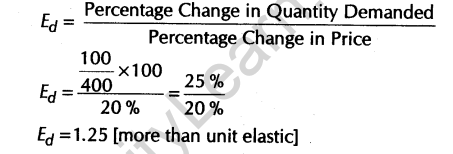
32.Price Elasticity of Demand of a good is – (0.75). Calculate the percentage fall in its price that will result in 15% rise in its demand.(All India 2013)
Ans.

33. 5% Fall in the price of a good raises its demand from 300 units to 318 units. Calculate its Price Elasticity of Demand.(All India 2013)
Ans.
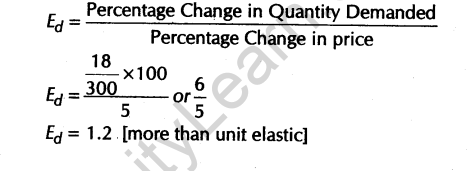
34.The demand rises by 20% as a result of fall in its price. Its Price Elasticity of Demand is (-) 0.8. Calculate the percentage fall in price.(Delhi 2013)
Ans.
 35.When price of a good is 7 per unit, a consumer buys 12 units. When price falls to 6 per unit, he spends 72 on the good. Calculate Price Elasticity of Demand by using percentage method. Comment on the likely shape of demand curve based on this measure of elasticity. (Delhi 2012)
35.When price of a good is 7 per unit, a consumer buys 12 units. When price falls to 6 per unit, he spends 72 on the good. Calculate Price Elasticity of Demand by using percentage method. Comment on the likely shape of demand curve based on this measure of elasticity. (Delhi 2012)
Ans.
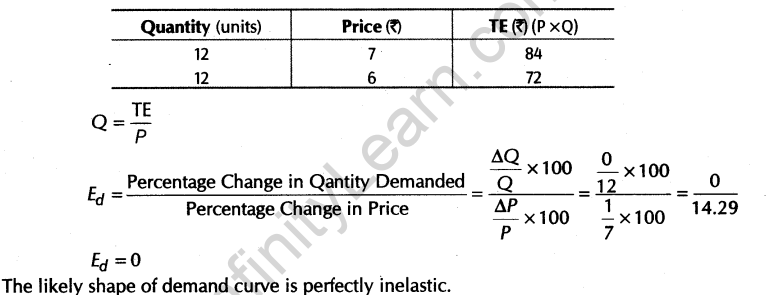
36.A consumer buys 10 units of a good at a price of 9 per unit. At price of 10 per unit, he buys 9 units. What is Price Elasticity of Demand? Use expenditure approach. Comment on the likely shape of demand curve based on this measure of elasticity (Delhi 2012)
Ans.

As per the expenditure approach, when with a change in price, the Total Expenditure remains unchanged, demand is unitary elastic (E^ =1). [Demand curve will have a normal shape with equal percentage change in price and quantity demanded].

37.A consumer buys 20 units of a good at a price of 5 per unit. He incurs an expenditure of 120 when he buys 24 units. Calculate Price Elasticity of Demand using the percentage method. Comment on the likely shape of demand curve based on this information(Delhi 2012)
Ans.
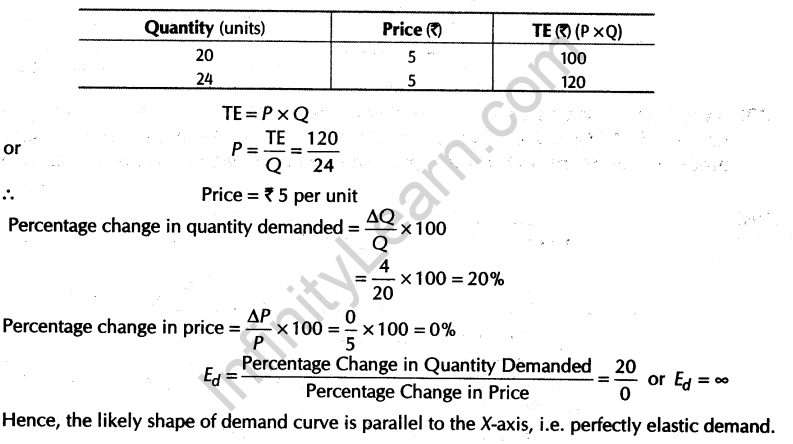
38.A consumer buys 10 units of a commodity at a price of 10 per unit. He incurs an expenditure of 200 on buying 20 units. Calculate Price Elasticity of Demand by percentage method. Comment on the shape of demand curve based on this information. (All India 2012)
Ans.
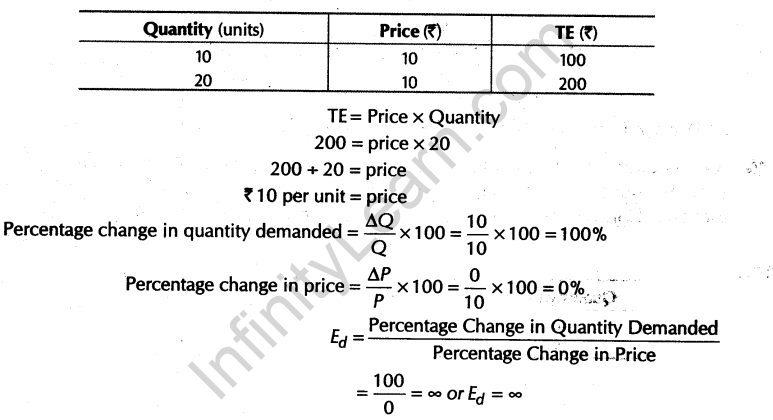
Elasticity of demand is perfectly elastic. Therefore, demand curve is a straight line parallel to x-axis.
 39.A consumer buys 14 units of a good at a price of 8 per unit. At price of 7 per unit, he spends 198 on the good. Calculate Price Elasticity of Demand by percentage method. Comment on the shape of demand curve based on this information.(All India 2012)
39.A consumer buys 14 units of a good at a price of 8 per unit. At price of 7 per unit, he spends 198 on the good. Calculate Price Elasticity of Demand by percentage method. Comment on the shape of demand curve based on this information.(All India 2012)
Ans.
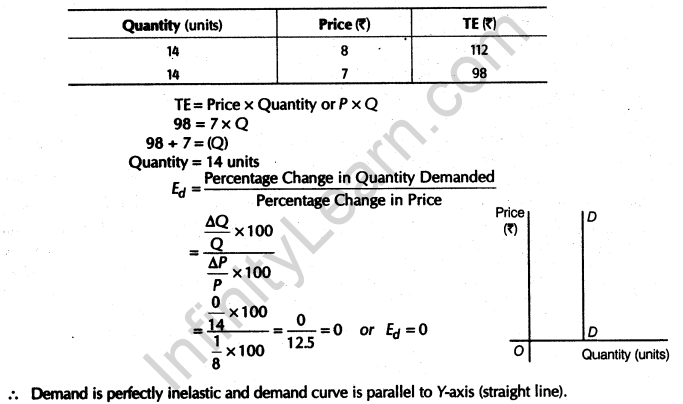
40.A consumer buys 8 units of a good at a price 7 per unit. When price rises to 8 per unit, he buys 7 units. Calculate Price Elasticity of Demand through expenditure method. Comment on the shape of demand curve based on this information.(AID India 2012)
Ans.

As per the expenditure approach, when with-a change in price, the Total Expenditure remains unchanged, demand is unitary elastic (£</ = 1). [Demand curve will have a normal shape with equal percentage change in price and quantity demanded].

41.Explain the effect of the following on Price Elasticity of Demand of a good
(i)Number of substitutes of a good
(ii)Proportion of income spent on the good (AH India 2011)
Ans.The two main factors that affect Price Elasticity of Demand are:
(i) Number of substitutes of a goods Demand for goods which have close substitutes (like tea and coffee) is relatively more elastic. Because, when price of such a good rises, the consumers have the option of shifting to its substitute. Goods without close substitutes like cigarettes etc are generally found to be less elastic or inelastic in demand.
(ii) Proportion of income spent on the goods On which consumers spend a small proportion of their income (toothpaste, needles, etc) will have an inelastic demand. On the other hand, goods on which the consumers spend a large proportion of their income (cloth, television, etc) tend to have elastic demand.
42.Explain the relationship between Price Elasticity of Demand and Total Expenditure. (Ml India 2011)
Ans. Relation between Price Elasticity of Demand and Total Expenditure are as follows:
Total Expenditure is calculated by multiplying price with quantity, i.e. TE = PxQ
(i)If Total Expenditure remains unchanged with increase or decrease in price then it is unitary elastic demand.
(ii)If direction of change in Total Expenditure is opposite to the direction of change in price i.e. with rise is Price Total Expnediture falls and vice-versa. Then, it is greater than unitary elastic demand.
(iii)If direction of change in Total Expenditure is the same as the direction of change in price i.e. with rise in Price Total Expenditure rises and vice-versa. Then, it is less than unitary elastic demand.

43.Calculate Price Elasticity of Demand by percentage method (All India 2011)
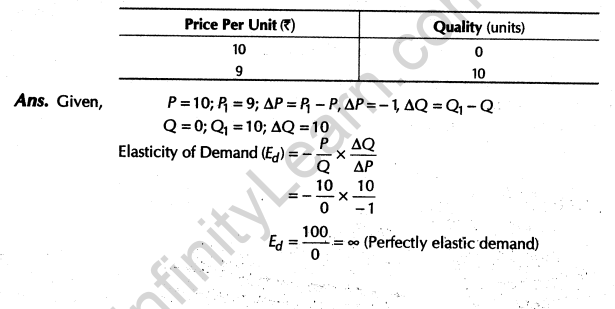
44.When price of a commodity falls from ? 8 per unit to 7 per unit, Total Expenditure on it increases from 200 to 210. Calculate its Price Elasticity of Demand by percentage method.(Delhi 201 ic)
Ans.
45.The price of a commodity is 20 per unit and Total Expenditure on it is 1000. When its price falls to 18 per unit, Total Expenditure increases by 8%. Calculate its Price Elasticity of Demand by percentage method.(Delhi2011C)
Ans.

46.When price of a commodity falls by 2 per unit, its quantity demanded increases by 10 units. Its Price Elasticity of Demand is (-) 1. Calculate its quantity demanded at a price before change which was 10 per unit(Delhi 2010)
Ans.
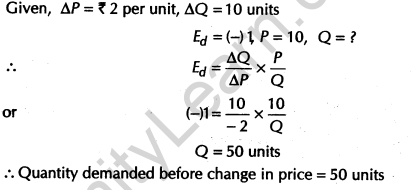 47.When price of a commodity falls by 1per unit, its quantity demanded rises by 3 units. Its Price Elasticity of Demand is (-) 2. Calculate its quantity demanded if the price before change was 10per unit. (All India 2010)
47.When price of a commodity falls by 1per unit, its quantity demanded rises by 3 units. Its Price Elasticity of Demand is (-) 2. Calculate its quantity demanded if the price before change was 10per unit. (All India 2010)
Ans.
48.The Price Elasticity of a Commodity is (-) 1.5. When its price falls by? 1 per unit, its quantity demanded rises by 3 units. If the quantity demanded before the price change was 30 units, what was the price at this demand? Calculate. (AN India 2010)
Ans.
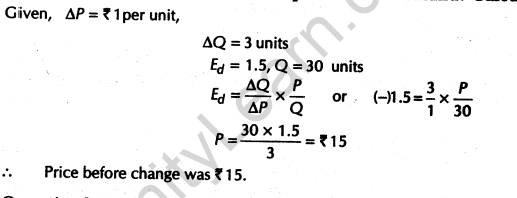
49. Quantity demanded of a commodity rises by 6 units, when its price falls by 1 per unit. Its Price Elasticity of Demand is (-) 1. If the price before the change was 20 per unit, calculate quantity demanded at this price.(AN imfia 2010)
Ans.
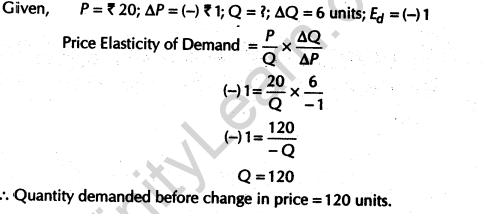
50. Calculate Price Elasticity of Demand by percentage method.(All India 2010)


51.From the following schedule, calculate Price Elasticity of Demand by comparing Totcil Expenditure on the good.(Delhi 2010c)

52.On the basis of the following schedule, calculate Price Elasticity of Demand by percentage method.(Delhi 2010C)

53.A consumer buys 40 units of a good at a price of 3 per unit. When price rises to? 4 per unit, he buys 30 units. Calculate Price Elasticity of Demand by Total Expenditure method. (Delhi 2007)
Ans.

As per the expenditure approach, when with a change in price, the Total Expenditure remains unchanged, demand is unitary elastic(Ed=1)
54.A consumer buys 80 units of a good at a price of 5 per unit. Suppose Price Elasticity of Demand is (-) 2. At what price will he buy 64 units?(Delhi 2007)
Ans.
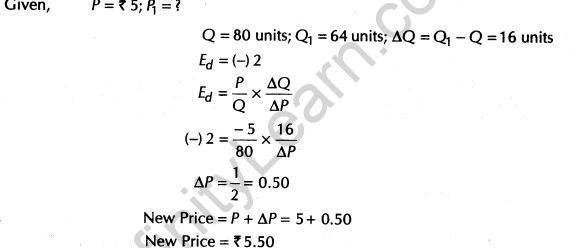 55.When price of a good falls by 10%, its quantity demanded rises from 40 units to 50 units. Calculate Price Elasticity of Demand by percentage method.
55.When price of a good falls by 10%, its quantity demanded rises from 40 units to 50 units. Calculate Price Elasticity of Demand by percentage method.
(All India 2007)
Ans.

56.A consumer buys 50 units of a good at a price of 10 per unit. When price falls by 5
per unit, he buys 100 units. Find out Price Elasticity of Demand by Total Expenditure method.(All India 2007)
Ans.

57.Demand of a product is elastic. Its price falls. What will be its effect on total Expenditure on the product? ,Give a numerical example.(Hots;Delhi2006c)
Ans.








